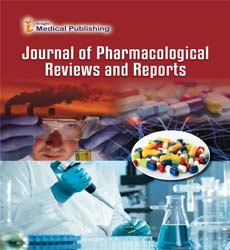Treatment and Management of Amphetamine Toxicity
Erik Vik*
Department of Toxicology, University of Bradford, Bradford City, United Kingdom
- *Corresponding Author:
- Erik Vik
Department of Toxicology
University of Bradford
Bradford City, United Kingdom
E-mail: virik@gmail.com
Received Date: October 6, 2021; Accepted Date: October 20, 2021; Published Date: October 27, 2021
Citation: Vik E (2021) Treatment and Management of Amphetamine Toxicity. J Pharmacol Rev Rep Vol.4 No.2:005.
Description
Amphetamines are a class of compounds that are abused in many regions of the world, including the United States, Australasia, and Europe. Amphetamine abuse potentials include prescription drugs, which are commonly used for attention deficit disorders, and various over-the-counter diet pills.
The clinical effects of amphetamine abuse are significant and are often seen in emergency rooms. Hendrickson et al. found that approximately 2.4% of visits to its facilities were related to methamphetamphetamine use and estimated annual hospital costs of $ 6.9 million. Patients may experience a variety of psychiatric and medical problems, including life-threatening restlessness, psychosis, seizures, and arrhythmias.
Pathophysiology
Amphetamines are a group of structurally related compounds that affect CNS, peripheral nervous system. The phenylethylamine structure of amphetamines resembles catecholaminergic, dopaminergic and serotonergic agonists (biogenic amines), which could explain their effects.
Central nervous system
Amphetamine compounds cause a general outflow of biogenic amines from neuronal synaptic terminals (indirect sympathomimetics). They inhibit specific transporters that are responsible for the reuptake of biogenic amines from synaptic nerve endings and presynaptic vesicles. Amphetamines also inhibit monoamine oxidase, which breaks down intracellular biogenic amine neurotransmitters. The net effect is an increase in neurotransmitter release at the synapse. Physiological adaptation occurs through receptor down-regulation or coupling; this tolerance and the accompanying psychological tolerance can lead to increased drug use and increased toxicity. Long-term use can lead to the depletion of biogenic amine stores and a paradoxical reverse effect of the drug-a washout.
Elevated catecholamine levels generally result in agitation and decreased fatigue. Elevated dopamine levels at CNS synapses can be responsible for movement disorders, schizophrenia, and euphoria. Serotonergic signals can influence the hallucinogenic and anorexic aspects of these drugs.
Cardiovascular system
The catecholaminergic (sympathomimetic) effects of amphetamines include inotropic and chronotropic effects on the heart that can cause tachycardia and other arrhythmias. The vasoconstrictive properties of the drugs can cause coronary hypertension and vasospasm.
The serotonergic effect of amphetamines on the peripheral vascular system can cause vasoconstriction, which is particularly problematic in placental vessels. Animal studies have shown that the serotonergic effects of amphetamines cause changes in the plasma levels of oxytocin, somatostatin, gastrin, and cholecystokinin. Long-term use of drugs can cause myonecrosis and dilated cardiomyopathy. Amphetamine use has also been linked to myocardial infarction.
Mechanism of Action
Amphetamine is a central nervous system (CNS) stimulant that is activated by increasing dopamine levels, norepinephrine, and serotonin (to a lesser extent) in the synaptic cleft by various mechanisms. Amphetamine enters the presynaptic axon terminal by diffusion or absorption by the monoamine transporters DAT, NET, and SERT. Once at the presynaptic terminal, amphetamine increases the amount of monoamine neurotransmitters in the cytosol by inhibiting the vesicular monoamine transporter 2 (VMAT2) and at the same time interrupting the electrochemical gradients necessary for the function of the vesicular transporter.
Amphetamine also inhibits the metabolism of monoamine neurotransmitters by inhibiting monoamine oxidase (MAO). At the same time, amphetamine stimulates the intracellular receptor TAAR1, which induces internalization or inversion of the DAT transporter. The effects of TAAR1 on DAT can also extend to NET and SERT, although colocalization of TAAR1 with these two transporters has so far only been indirectly demonstrated in studies. The net result of this activity is increased dopamine efflux into the synaptic cleft and inhibition of synaptic cleft reuptake through DAT internalization and direct competition.
Contraindications
Amphetamine is contraindicated in hypersensitive patients to any component of the drug formulation. Amphetamine is also used during or within 14 days of MAOI therapy, e.g., Eg B. phenelzine, contraindicated due to the risk of hypertensive crisis. Other contraindications are symptomatic cardiovascular disease, advanced arteriosclerosis, glaucoma, hyperthyroidism, severe hypertension, agitation, and a history of drug abuse.
Treatment
Patients with acute amphetamine poisoning require chemical and physical restraints to avoid self-harm or harm to others, as these severely paranoid patients can be hostile. Some lifethreatening signs and symptoms need urgent treatment, such as: B. trauma, airway disturbance, seizures, and cardiac arrhythmias. A patient can be treated with supportive therapy with sedation and observation if there are no life-threatening signs and symptoms. Medications that provide supportive treatment include benzodiazepines for sedation and seizure control, activated charcoal in some cases when the patient is conscious and can be taken orally as this can help reduce the absorption of amphetamines from the tract digestive and fluids to treat dehydration. Deaths related to amphetamine toxicity are rare; however, the risk of death is higher if a patient uses amphetamines while taking other medications or overdoses.
Open Access Journals
- Aquaculture & Veterinary Science
- Chemistry & Chemical Sciences
- Clinical Sciences
- Engineering
- General Science
- Genetics & Molecular Biology
- Health Care & Nursing
- Immunology & Microbiology
- Materials Science
- Mathematics & Physics
- Medical Sciences
- Neurology & Psychiatry
- Oncology & Cancer Science
- Pharmaceutical Sciences
